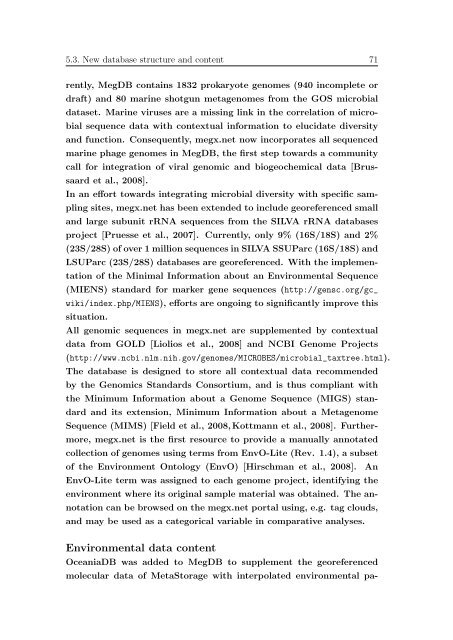Data integration in microbial genomics ... - Jacobs University
Data integration in microbial genomics ... - Jacobs University
Data integration in microbial genomics ... - Jacobs University
Create successful ePaper yourself
Turn your PDF publications into a flip-book with our unique Google optimized e-Paper software.
5.3. New database structure and content 71<br />
rently, MegDB conta<strong>in</strong>s 1832 prokaryote genomes (940 <strong>in</strong>complete or<br />
draft) and 80 mar<strong>in</strong>e shotgun metagenomes from the GOS <strong>microbial</strong><br />
dataset. Mar<strong>in</strong>e viruses are a miss<strong>in</strong>g l<strong>in</strong>k <strong>in</strong> the correlation of <strong>microbial</strong><br />
sequence data with contextual <strong>in</strong>formation to elucidate diversity<br />
and function. Consequently, megx.net now <strong>in</strong>corporates all sequenced<br />
mar<strong>in</strong>e phage genomes <strong>in</strong> MegDB, the first step towards a community<br />
call for <strong><strong>in</strong>tegration</strong> of viral genomic and biogeochemical data [Brussaard<br />
et al., 2008].<br />
In an effort towards <strong>in</strong>tegrat<strong>in</strong>g <strong>microbial</strong> diversity with specific sampl<strong>in</strong>g<br />
sites, megx.net has been extended to <strong>in</strong>clude georeferenced small<br />
and large subunit rRNA sequences from the SILVA rRNA databases<br />
project [Pruesse et al., 2007]. Currently, only 9% (16S/18S) and 2%<br />
(23S/28S) of over 1 million sequences <strong>in</strong> SILVA SSUParc (16S/18S) and<br />
LSUParc (23S/28S) databases are georeferenced. With the implementation<br />
of the M<strong>in</strong>imal Information about an Environmental Sequence<br />
(MIENS) standard for marker gene sequences (http://gensc.org/gc_<br />
wiki/<strong>in</strong>dex.php/MIENS), efforts are ongo<strong>in</strong>g to significantly improve this<br />
situation.<br />
All genomic sequences <strong>in</strong> megx.net are supplemented by contextual<br />
data from GOLD [Liolios et al., 2008] and NCBI Genome Projects<br />
(http://www.ncbi.nlm.nih.gov/genomes/MICROBES/<strong>microbial</strong>_taxtree.html).<br />
The database is designed to store all contextual data recommended<br />
by the Genomics Standards Consortium, and is thus compliant with<br />
the M<strong>in</strong>imum Information about a Genome Sequence (MIGS) standard<br />
and its extension, M<strong>in</strong>imum Information about a Metagenome<br />
Sequence (MIMS) [Field et al., 2008, Kottmann et al., 2008]. Furthermore,<br />
megx.net is the first resource to provide a manually annotated<br />
collection of genomes us<strong>in</strong>g terms from EnvO-Lite (Rev. 1.4), a subset<br />
of the Environment Ontology (EnvO) [Hirschman et al., 2008]. An<br />
EnvO-Lite term was assigned to each genome project, identify<strong>in</strong>g the<br />
environment where its orig<strong>in</strong>al sample material was obta<strong>in</strong>ed. The annotation<br />
can be browsed on the megx.net portal us<strong>in</strong>g, e.g. tag clouds,<br />
and may be used as a categorical variable <strong>in</strong> comparative analyses.<br />
Environmental data content<br />
OceaniaDB was added to MegDB to supplement the georeferenced<br />
molecular data of MetaStorage with <strong>in</strong>terpolated environmental pa-

















